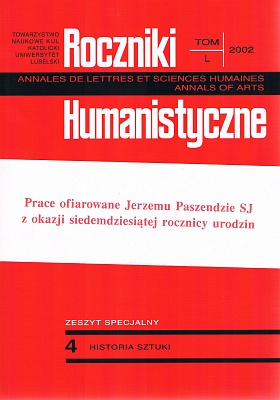„Jezuickie intrygi” a problem stylu w ukraińskiej architekturze cerkiewnej drugiej połowy XIX wieku
Abstrakt
One of the main elements of the Ukrainian national identity in Galicia was the attachment to the Greek-Catholic Church. From the time of the Spring of the Nations the Uniate priests became the main animators of the Ukrainian ‘national awakening’. They were involved in this activity also when performing their pastoral duties, or even liturgical ones. One cannot then wonder that looking for the Ukranian national style in architecture was done almost exclusively within Orthodox church building, and the choice of forms used in Greek-Catholic churches was a peculiar reflection of the discussion by the Church elites, in which the debate on the character of the Greek rite was interwoven with attempts at defining the vision of the Ukrainian nation and its place in Europe.
In the sixties of the 19th century the pro-Moscow fraction had a strong influence among priests; it tried to prove close ethnical ties between the Ukrainians and Russians and wanted to ‘purify’ the Uniate rite from elements borrowed from Roman-Catholic liturgy owing to – as they said – ‘a Jesuit plot’. However, one of the most ardent Moscow-phils, Rev. Jan Naumowicz, admired the activity of the Russian Ivan Martynov, a member of the Society of Jesus and consultor of the congregation Propaganda Fide for eastern rites. Rev. Martynov wanted to reform the Uniate Church in such a way that it would serve first of all the idea of converting Russia to Catholicism. The idea of building an orthodox church in Lvov in the ‘purely Byzantine’ style, where Jesuits were to say the Holy Mass in the Greek rite, was an interesting element of the programme, especially praised by Rev. Naumowicz. It is almost certain that the structure was to be kept in the forms of the official Russian Orthodox church style worked out in the forties of the 19th century by Konstantin Thon.
Opponents of the pro-Moscow fraction considered the clergymen belonging to it clandestine advocates of the Orthodox Church. Hence the neo-Byzantine stylistic solutions suggested by the Russian and propagated by the fervent adherent to a kind of Russification of the Uniate Church could be seen by them as ‘schismatic’. The neo-Byzantine forms given to the dome of the Przemyśl Greek-Catholic cathedral in 1866 met a lot of criticism and resulted in pulling it down soon. The basic tendency in Greek-Catholic church architecture in Galicia was looking for models for Orthodox and Uniate churches ‘in the many centuries old tradition of the Ukrainian architecture’. From it first the model of tripartite, three-domed church was derived, and a little later – the cross-shaped church with one dome. From the eighties of the 19th century the architect Vasil Nahirnyi started decorating the churches in the neo-Byzantine costume, however, looking for models in the cosmopolitic neo-Byzantinism of Theophil Hansen and avoiding all connections with the ‘schismatic’ style of Russian Orthodox churches. Nahirnyi’s neo-Byzantinism was accepted by Ukrainians as their national Uniate church style, which was probably connected with the provisions of the Lvov Synod (1891) that officially granted the Greek-Catholic rite the character of the Ukrainian national denomination. The Lvov initiative of Father Martynov proved to be only an interesting episode in the history of Greek- Catholic church architecture in Galicia.
Copyright (c) 2002 Roczniki Humanistyczne

Utwór dostępny jest na licencji Creative Commons Uznanie autorstwa – Użycie niekomercyjne – Bez utworów zależnych 4.0 Międzynarodowe.





